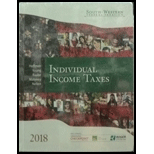
South-western Federal Taxation 2018: Individual Income Taxes
41st Edition
ISBN: 9781337385886
Author: William H. Hoffman, James C. Young, William A. Raabe, David M. Maloney, Annette Nellen
Publisher: Cengage Learning
expand_more
expand_more
format_list_bulleted
Question
Chapter 19, Problem 1DQ
To determine
Ascertain whether each of the following independent statements is best applied to a defined contribution plan (DCP), a defined benefit plan (DBP), Both (B), or neither (N).
Expert Solution & Answer
Explanation of Solution
Defined contribution plans: In a defined contribution plan, the additions made to an employee’s account annually cannot exceed the lesser;
- “$56,000 (during 2019)”, (or)
- “100 percent of the compensation made by the employees”.
Defined Benefit plans: In a defined benefit plan, the annual benefit paid to an employee is restricted to the lesser of the following;
- “$225,000 (in 2019)” or
- “100% of the average compensation for the highest three years of employment”.
Ascertain whether each of the following independent statements is best applied to a defined contribution plan (DCP), a defined benefit plan (DBP), Both (B), or neither (N).
| Serial Number | Applied to the best of |
| a. | DBP. |
| b. | DCP. |
| c. | DBP. |
| d. | N. |
| e. | DBP. |
| f. | B. |
| g. | N. |
| h. | DCP. |
| i. | DCP. |
| j. | DBP. |
Table (1)
Want to see more full solutions like this?
Subscribe now to access step-by-step solutions to millions of textbook problems written by subject matter experts!
Students have asked these similar questions
Need Correct Option of this General Accounting Question
Subject = Cost Account
Hello can u help me with this problem
Chapter 19 Solutions
South-western Federal Taxation 2018: Individual Income Taxes
Ch. 19 - Prob. 1DQCh. 19 - Prob. 2DQCh. 19 - Prob. 3DQCh. 19 - Prob. 4DQCh. 19 - Prob. 5DQCh. 19 - Prob. 6DQCh. 19 - Prob. 7DQCh. 19 - Prob. 8DQCh. 19 - Prob. 9DQCh. 19 - Prob. 10DQ
Ch. 19 - Prob. 11DQCh. 19 - Prob. 12DQCh. 19 - Prob. 13DQCh. 19 - Prob. 14CECh. 19 - Prob. 15CECh. 19 - Prob. 16CECh. 19 - Prob. 17CECh. 19 - Prob. 18CECh. 19 - Prob. 19CECh. 19 - Prob. 20CECh. 19 - Prob. 21CECh. 19 - Prob. 22CECh. 19 - Prob. 23CECh. 19 - Prob. 24CECh. 19 - Prob. 25CECh. 19 - Prob. 26CECh. 19 - Prob. 27PCh. 19 - Prob. 28PCh. 19 - Prob. 29PCh. 19 - Prob. 30PCh. 19 - Prob. 31PCh. 19 - Prob. 32PCh. 19 - Prob. 33PCh. 19 - Prob. 34PCh. 19 - Prob. 35PCh. 19 - Prob. 36PCh. 19 - Prob. 37PCh. 19 - Prob. 38PCh. 19 - Prob. 39PCh. 19 - Prob. 40PCh. 19 - Prob. 41PCh. 19 - Prob. 42PCh. 19 - Prob. 43PCh. 19 - Prob. 44PCh. 19 - Prob. 45PCh. 19 - Prob. 46PCh. 19 - Prob. 47PCh. 19 - Prob. 48PCh. 19 - Prob. 49PCh. 19 - Prob. 50PCh. 19 - Prob. 51PCh. 19 - Prob. 52PCh. 19 - Prob. 53PCh. 19 - Prob. 54PCh. 19 - Prob. 55PCh. 19 - Prob. 56PCh. 19 - Prob. 57PCh. 19 - Prob. 1RPCh. 19 - Prob. 2RPCh. 19 - Prob. 3RPCh. 19 - Prob. 6RPCh. 19 - Prob. 1CPACh. 19 - Prob. 2CPACh. 19 - Prob. 3CPACh. 19 - Prob. 4CPACh. 19 - Prob. 5CPA
Knowledge Booster
Similar questions
- Only expert of financial accounting can accept thisarrow_forwardCalculate the inventory days on hand, assuming:arrow_forwardAdam, Azim and Akbar were equal partners in a firm. Each partner contributed capital of RO 15,000, RO 10,000 and RO 5,000 on 1st January 2022. General reserve of the firm was 18,000 and Un-distributed Profits of RO 15,000 on 31st December 2022. The value of goodwill in the balance sheet was RO 25,000. Mr. Adam met an accident and he died on 30th September 2022. The partnership provides that the representative of the deceased partner shall be entitled to balance of the capital account of the deceased partner. Interest on capital @ 5% is allowed as per partnership deed. His share of profits up to date of death on the average of last 3 years’ profit. Profits for the last 3 years was R.O 6000, R.O 2000 and R.O 1,500. Calculate the amount payable to legal representative of Mr. Adam. Also prepare the necessary ledger accounts. All calculations and the ledgers should be handwritten. You should upload the photo of your calculations and ledgers on the e-learning.arrow_forward
arrow_back_ios
SEE MORE QUESTIONS
arrow_forward_ios
Recommended textbooks for you
